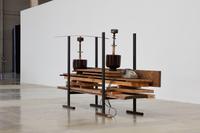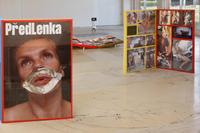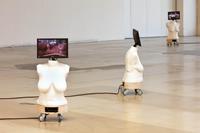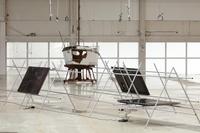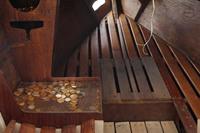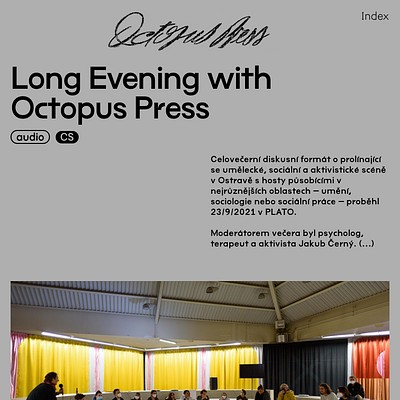Oh and Hah, Beauty, Ruin and Slack
- text
- 900 words
- cs
- en
English translation: Kateřina Danielová
The curator’s throwback to 2021’s exhibition cycle dedicated to ruins
Ruins in the world, human and posthuman. The year-long cycle devoted to the processes, manifestations and images of the ruination of the world as we know it, will conclude with a fifth scene – a tragedy in seven acts, curated by Pierre Bal-Blanc, When I state that I am an anarchist. It is a solo exhibition and a series of performances loosely inspired by the personality of Christopher D’Arcangelo (March–May 2022). The fifth scene is titled Ruin of Investigation and is a metaphor for archaeological deconstruction and new construction as well; it is reflexive in nature, as is this look back at the four established scenes of PLATO’s year-long project Oh and Hah, Beauty, Ruin and Slack.
The exhibitions held within the series met in the gallery quite organically as if in a garden, and dramatically like characters on a theatre stage, thus demonstrating the phenomena taking place in the ruins, with no clear beginning and end; in a continuous transformation and a recurring intertwining, passing by and meeting again. The best way to understand the phenomena and see the exhibitions is long observation from a given place.
A place subject to ruination was the motif of the first scene, Metamorphosis. We were interested in the situation of the PLATO Gallery itself, its relocation to a new venue – the former municipal slaughterhouse – and the expected gentrification processes associated with relocations of this kind. Within the Transformation, Lukáš Jasanský and Martin Polák presented a documentation series on the exhibition that they organised for themselves in the slaughterhouse rooms under reconstruction. Their intervention titled A Foreman’s Work anticipated the institution as such. The exhibition Classicon featured an installation and paintings by Richard Nikl and a text by Jiří Maha; both together and each on their own, the artists reflected on our (un)tiring need to create universal values, on fossilising or shrinking hierarchies, on today’s forgetting, unravelling, sequential prototyping, the need for language and sustainability. Patrick Keiller’s film trilogy London – Robinson in Space – Robinson in Ruins, a visual essay identifying the many manifestations of the ruination of the economic environment in the United Kingdom of Great Britain and Northern Ireland under the Conservative government of 1979–1997, provided a classic foundation for our exploration. Micol Assaël’s exhibition Converting Words was an account of her investigations into natural, electromagnetic and physical phenomena and forces as well as their physical, psychological, aesthetic and linguistic transformations for human perceptions.
The second scene, Time of Mourning, dealt with rites of passage and our mental adaptation to change. Lazy Flower, Kris Lemsalu’s mobile avatar created from the ruins of the past exhibitions, reported on a holistic way of perceiving the world and a rebellious plant kingdom. Taus Makhacheva’s film Baida connects the worlds of the refugee crisis and art tourism, and Lili Reynaud Dewar’s film Beyond the Land of Minimal Possessions is a feminist-queer horror deconstruction of the monument to minimalism in Marfa, Texas, and tourism associated with it. In the exhibition Leatherette and Other Imitations, Lenka Klodová presented an original construction of her own retrospective of performances and actions related to nudity and female corporeality in ruins linking the intimate with the political.
The third scene Ruin, Differentiation was intended to take us through a process of progressive diversification. New forms of kinship, independent of genders, sexes, races, species, classes, parties, citizenships, minorities, and religions are supposed to protect society from disruptive fragmentation. In the exhibition Oh and Hah and Oof. Somewhat More on Pedig/queer/ree, Anna Daučíková and her co-performer, curator and philosopher Nor Lacko comments – through bodies as biological semi-finished products and glass panes as industrially predetermined ones – on the self-awareness of the transgender situation of not only their own bodies but also of the collective body of society, as well as the queer nature of the neurons of the entire material world. In his exhibition Valentines / Ash Wednesday, Daniel Rycharski attempts to overcome the binary social norms that do not meet the needs of today’s gay Catholics by homeopathically ingesting the ashes of a confessional kneeler mixed with the ashes of a gay club wall. In the exhibition Skeleton. The Second Part of a Euro-Medieval Saga, Jan Boháč and Viktor Dedek use the game world to open up the boundaries of our bodies, descend beneath their tissues and loosen the notions of our possible identities. Marek Pražák observes modern humans and society in historical, mythological, biblical time, news time and cosmic time. He shows us the ruins on which our identities rest, and assembles, in the role of a preacher, The Twelve Commandments for the 21st century in order to “ensure” that the ruins are able to sustain our demands for a good life.
Smouldering Ruin, an Image – the fourth scene is about the scene itself, about the relationship between representation and ruin. The Verbal Slip exhibition by Daniela Dostálková and Linda Dostálková cuts across the correctness of our conscious life in times of crisis and altruism, a correctness excluding humour and becoming the norm. The critical examination takes place within the framework of feminist thought.
Our exploration of the present through the processes of ruination as well as the metaphor and method of the ruin consists not only of exhibitions, but also of other programmes, including the newly founded Octopus Press that follows the example of the work of the legendary alternative bookstore and publishing house in Athens which, between 1974 and 1976, was a platform for collective artistic experimentation, activist expression, environmental thinking and non-conformist encounters.
←→
- Language
- Type
- Palate Cleanser2025
- cs
- en
text- 2,000 words
- Monika Pascoe Mikyšková: Memories that aren’t mine2025
- cs
- en
text- 500 words
- Kino Kosmos under the Cosmic Sun2025
- cs
- en
text- 9,800 words
- Kino Kosmos2025
- cs
- en
text- 3,700 words
- Dorota Jurczak: Pyk, Sciak etc.2025
- cs
- en
text- 1,500 words
- Sprouts2025
- cs
- en
text- 800 words
- Curatorial text for the exhibition by Petr Bosák, Robert Jansa and Adam Macháček2025
- cs
- en
text- 900 words
- Curatorial text for Martin Zetová's exhibition2025
- cs
- en
text- 1,100 words
- Cello & Piano2025
- cs
- en
audio - Primeval Forest, Garden and Wall2024
- cs
- en
- pl
text- 1,100 words
- Interview with Barbora Lungová2024
- cs
audio - Barbora Lungová and the gift of painting2024
- cs
- en
text- 1,400 words
- Julie in the Worlds of Fantasy. Marginalia.2024
- cs
- en
text- 1,600 words
- Pigeon newspaper2024text
- Workbook for children The Shell No. 32024
- cs
- en
text- 200 words
- Zvířecí kustodi – Bee2024
- cs
- en
video- 32’32”
- Animal Custodians – Rabbit2024
- cs
- en
video- 33’18”
- Animal Custodians – Owl2024
- cs
- en
video- 28’05”
- Animal Custodians – Fox2024
- cs
- en
video- 32’05”
- Animal Custodians – Deer2024
- cs
- en
video- 33’45”
- Animal Custodians – Pigeon2023
- cs
- en
video- 32’20”
- Animal Custodians – Raven2023
- cs
- en
video- 21’24”
- If you have a canary with a poor singing voice, it will never stop singing after this training video!2023
- cs
- en
video- 21’24”
- Checking the Stove2023
- cs
- en
video- 5’34”
- 0’40”
- Trust2023
- cs
- en
video- 7’03”
- Is it the flight or the fall what my friend is falling for?2023
- cs
- en
video- 12’08”
- Animal News2023
- cs
- en
text- 1,500 words
- Dan Walwin: Relief2023
- cs
- en
text- 1,000 words
- Ukrainian Culture at the Time of Russian Aggression2023
- cs
- en
text- 100 words
- Freely Accessible Books on the Topic of Ukrainian Culture at the Time of Russian Aggression2023
- cs
- en
text- 500 words
- They Thought We Were Alive and They Run Screaming2023
- cs
- en
text- 1,200 words
- On Renewed Land: Locating Ukrainian Destiny2023
- cs
- en
text- 1,900 words
- I Can Hear the Grass Grow2023
- cs
- en
text- 600 words
- Interview related to the exhibition Optimised Fables about a Good Life2022
- cs
- en
text- 900 words
- Interview related to the exhibition Optimised Fables about a Good Life2022
- cs
- en
text- 900 words
- Interview related to the exhibition Optimised Fables about a Good Life2022
- cs
- en
text- 700 words
- Interview related to the exhibition Optimised Fables about a Good Life2022
- cs
- en
text- 1,700 words
- Interview related to the exhibition Optimised Fables about a Good Life2022
- cs
- en
text- 1,000 words
- Interview related to the exhibition Optimised Fables about a Good Life2022
- cs
- en
text- 1,100 words
- Interview related to the exhibition Optimised Fables about a Good Life2022
- cs
- en
text- 900 words
- Interview related to the exhibition Optimised Fables about a Good Life2022
- cs
- en
text- 1,600 words
- Interview related to the exhibition Optimised Fables about a Good Life2022
- cs
- en
text- 900 words
- Interview related to the exhibition Optimised Fables about a Good Life2022
- cs
- en
text- 1,400 words
- The Night2022
- cs
text- 0 words
- Optimised Fables about a Good Life2022
- cs
- en
text- 800 words
- In the footsteps of the Greek underground II: Longing for deep time2022
- cs
- en
text- 7,200 words
- In the footsteps of the Greek underground I2022
- cs
- en
text- 12,800 words
- Elective Affinities: “Anarchism Without Adjectives”. On the Work of Christopher D’Arcangelo 1975–1979 with Dean Inkster and Pierre Bal-Blanc2022
- cs
- en
video- 58’01”
- Curatorial Control2022
- cs
- en
text- 2,500 words
- Ruins. Reconstruction of the past and construction of the future2022video
- 1h 14’43”
- Long Evening with Octopus Press2022
- cs
audio - Oh and Hah, Beauty, Ruin and Slack2021
- cs
- en
text- 900 words
- Our Living Ruins2021
- cs
- en
- pl
text- 3,100 words
- Troubling Time/s and Ecologies of Nothingness: Re-turning, Re-membering, and Facing the Incalculable2021
- cs
- en
text- 16,400 words
- Re/un/doing the Ruin2021
- cs
- en
text- 2,800 words
- Usableness of the list / Portfolio2021
- cs
- en
audio - Tied to Landscapes2021
- cs
- en
text- 800 words
- Tied to Landscapes2021video
- 9’49”
- A Small Encyclopedia of Improprieties2021video
- 12’18”
- Humans need not apply2021
- cs
- en
text- 900 words
- Poems2021
- cs
- en
text- 200 words
- Carbon Care2021
- cs
- en
text- 1,400 words
- Bouvard and Pécuchet. A Tragi-comic Novel of Bourgeois Life2021
- cs
- en
- fr
text- 12,300 words
- And Again G. F.2021
- cs
- en
text- 700 words
- On The Immortality of Art Institutions2021
- cs
- en
- pl
text- 1,500 words
- Expedition PLATO2021video
- 47’25”
- The Great Transformation. The Political and Economical Origins of Our Time2021
- cs
- en
text- 4,800 words
- Digestive Tract2021video
- 14’35”
- Notre Dame of Ruins2021
- cs
- en
- fr
text- 1,100 words
- Who is Afraid of Ruins?2021
- cs
- en
- pl
text- 1,300 words
- The Ruin2021
- cs
- en
- de
text- 3,000 words
- Zapomínání a infrastruktura2021video
- 13’19”
- Forgetting and infrastructure2021
- cs
- en
text- 2,000 words
- Olympia2021image
- Purification II, 20202021video
- 3’35”
- Purification I, 20202021video
- 1’49”
- Chaos: how to ruin a ‘ruin’ and love a ‘ruin-in-love’, I think2021
- cs
- en
text- 5,400 words
- (Introduction) Chaos: how to ruin a ‘ruin’ and love a ‘ruin-in-love’, I think2021video
- 13’35”



